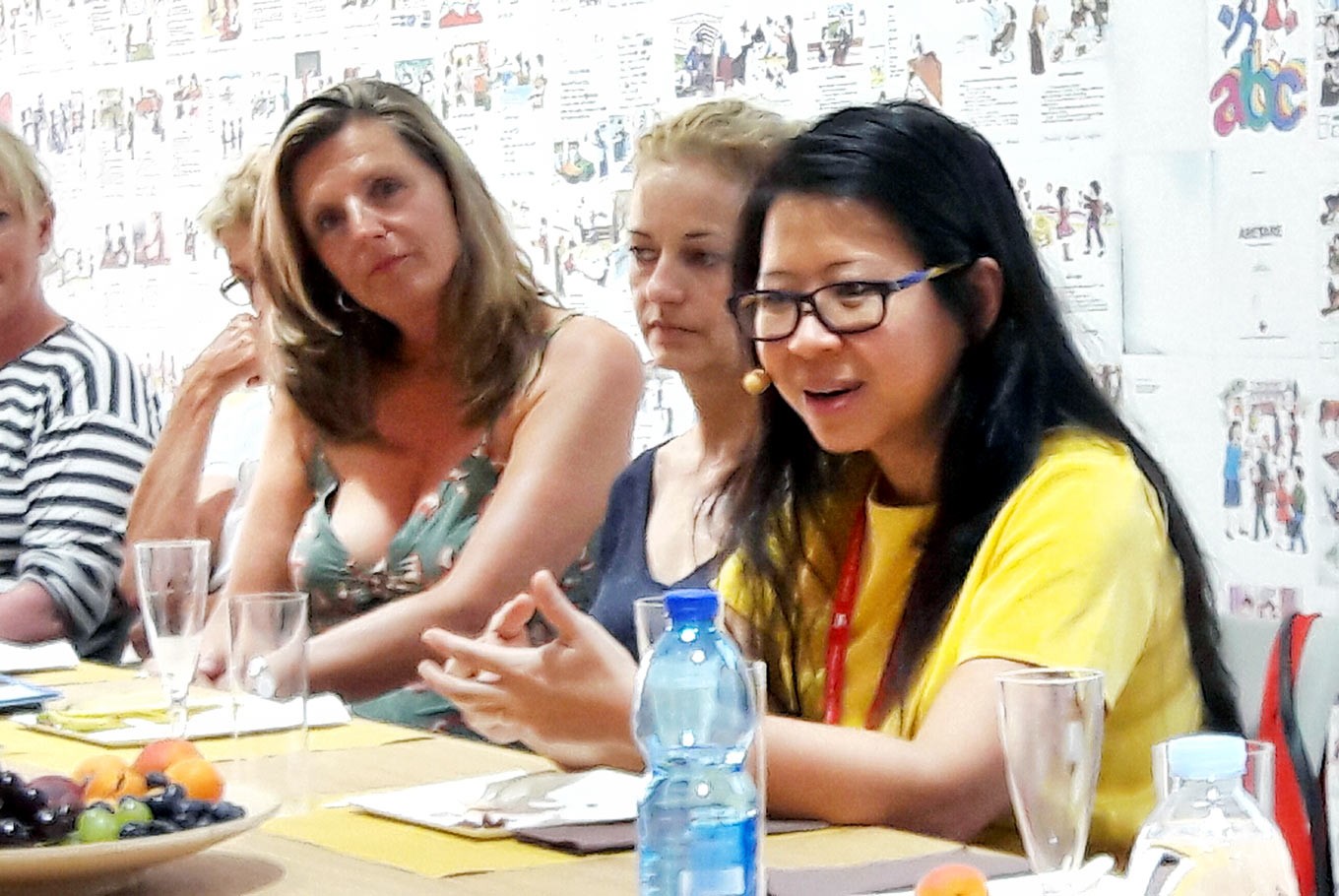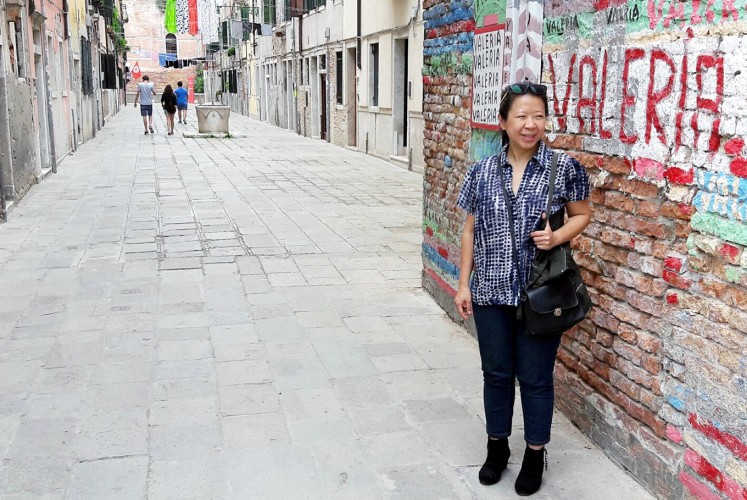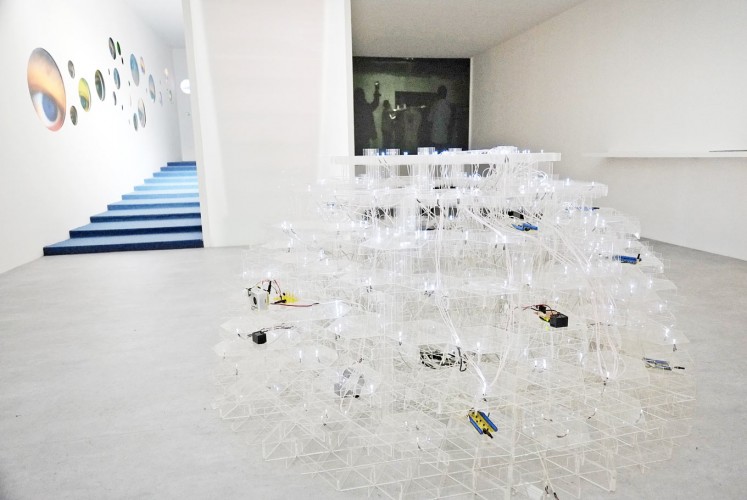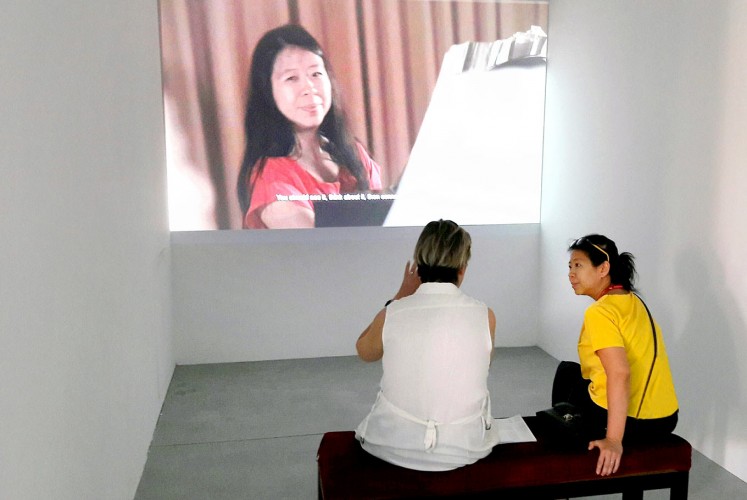Popular Reads
Top Results
Can't find what you're looking for?
View all search resultsPopular Reads
Top Results
Can't find what you're looking for?
View all search resultsArtist Tintin's struggle to uncover the truth
Change text size
Gift Premium Articles
to Anyone
T
hose who are familiar with the communist purge in 1965 will easily understand that the Denpasar-born artist is referring to a dark chapter in Indonesian history.
Exploring the latest works of Indonesian artist Tintin Wulia, 45, may give a semblance of following the thrilling adventures of her namesake, the famous investigative journalist character created by Belgian cartoonist Hergé.
The short movie 1001 Martian Homes, the dome-shaped installation Not Alone and another installation work, a staircase called Under the Sun, now being staged simultaneously at the Indonesian pavilion at the Venice Art Biennale 2017 in Italy and on the sixth floor of the Senayan City shopping mall in South Jakarta until mid-November, will thrust visitors into a journey to the future but at the same time provoke a sense of déjà vu.
Read also: Venice Biennale: A missed opportunity to keep Indonesia 'on the map'
The trinity of art works, entitled 1001 Martian Homes, is indeed a humanitarian message that knows no time and space boundaries. “In this project I stripped off time and place so that we can recognize a repetitive pattern in the history of humankind,” she says of her works.
The National Creative Economy Agency (Bekraf) selected Bali-born, Brisbane resident Tintin as the Indonesian representative at — and sponsored her participation in — the prestigious Venice art event, taking into account her internationally acclaimed achievements.
When watching the movie, those who are familiar with the communist purge in 1965 will easily understand that the artist is referring to this dark point in Indonesian history, when thousands fell victim to extra-judicial killings and many others were detained without trial.
There are too many similarities, rather than coincidences, between “reality” surrounding the anticommunist crackdown and the “imaginary” political persecution the characters in the movie claim to have endured. And the fact that the characters were political prisoners in their real lives all but underlines Tintin’s intention to contribute to the efforts to rewrite the sad episode of Indonesian history, which have intensified since the start of the reform era in 1998.
Walk of fame: Artist Tintin Wulia passes an alley in the Arsenale area of Venice, Italy, on her way to the venue of the Art Biennale 2017. (JP/Dwi Atmanta)Take Tedjobayu Sudjojono, who recalls how he struggled to memorize the title of the 16 editions of the encyclopedia that he used to read in his childhood in order to survive psychological pressures while in exile on Mars as a political prisoner in 2065. “As long as I could remember the titles I was sane,” he says.
Tedjo is not just following the script Tintin and her team have prepared. He is recounting his 14-year exile on Buru Island in Maluku, where he spent his time rewriting formulas in physics that he had learned.
By comparison, another Buru political prisoner Pramudya Ananta Toer survived his exile through writing novels — which later almost led him to be the first Indonesian to win the Nobel Prize for literature.
In fact Tedjo and his close friend Hersri Setiawan, who also appears in 1001 Martian Homes, starred in the documentary film Pulau Buru Tanah Air Beta(Buru Island, my homeland) directed by Hersri’s son historian Ken Setiawan, the screening of which was met with intimidation from hard-line groups in Jakarta last year. Ken helped Tintin in the 1001 Martian Homes project.
For Tintin the art works represent her own search for the truth behind the 1965-1966 atrocities, which anthropologist Robert Lemelson refers to as an Indonesian tragedy in his 2009 documentary movie.
Tintin is neither a historian nor an anthropologist, but her passion for the truth-seeking exercise, which she says is driven by the disappearance of her grandfather Liauw Liong Kee in the 1965 turmoil, constitutes awareness of the country’s new vision of Indonesian history.
Tintin’s knowledge of geopolitics is obvious in her choice of video footage of NASA’s space exploration in 1965 taken from the United States space agency’s Highlights 1965: A Progress Report as an illustration in her movie. She says she wants to show the US’ indifference to the humanitarian tragedy that was unfolding in Indonesia then.
She earned a PhD in art from RMIT University, Melbourne in 2014 through her work, which investigated the flux of geopolitical borders, made and unmade by people.
Humanitarian message: Tintin Wulia’s pieces, entitled 1001 Martian Homes, are on display on the sixth floor of the Senayan City shopping mall in South Jakarta. (JP/Jerry Adiguna)Tintin says she does not intend to link the communist purge with the US in any way, as some foreign and Indonesian scholars have done. Neither does she argue for any interpretation that connects her work with the US role in the 1965 crime against humanity in Indonesia.
There is a classic adage that remains prevalent until today that history belongs to the victors. While acknowledging the gross human rights violations Indonesia’s official history rules out any foreign intervention in the tragedy. Plus there has never been any admission of guilt from the government as representatives of the state to the victims.
As an artist Tintin has the luxury of exercising her power of imagination and improvisation through her use of metaphors and symbols. For many they blur facts and fiction, but at the same time they enrich the discourse on the historical juncture of 1965, about which many of the Tintin generation are unaware.
“My intention is to trigger discussions and I want to make people question and think. It’s more important for us to open our minds than rest on one single interpretation,” she says.
The Not Alone installation, which emulates her 2012 work The Butterfly Generator, is a 2-meter-diameter dome made of thousands of hexagonal modules made of laser-cut clear acrylic, electronic cables that include electroluminescent wires and processor boards bearing 228 glowing LED lights. Their arrangement is said to represent the stars of Sagittarius.
The other work, Under the Sun, features a stairway leading to a hidden room, along which guests can see blinking eyeballs (which actually belong to other guests) of various sizes on the wall.
There is nothing like Explorers on the Moon, Prisoners of the Sun or The Secret of the Unicorn in Tintin’s art works, but she and Hergé share much in common: They both offer adventures of the mind.
“What happened in Indonesia in 1965 also took place elsewhere in the world at different times, which evinces that we are not alone. And it may recur somewhere, someday in the future,” she says.
Tintin is not talking nonsense. History does repeat itself.
Interaction: A visitor discusses with artist Tintin Wulia her video 1001 Martian Homes at the Indonesian pavilion during the Venice Art Biennale 2017. (JP/Dwi Atmanta)Connecting with the past
The 1965 tragedy is a theme Indonesian contemporary artist Tintin Wulia has been engaging with for quite a long time. For one thing she is personally connected with the events, although she was born 17 years after they occurred.
Her grandfather Liauw Liong Kee suddenly disappeared as the crackdown on communists that followed the aborted coup attempt blamed on the Indonesian Communist Party (PKI) on Sept. 30 was imposed in several places across the country, including Bali, where Liauw’s family lived. Liauw was then a member of Baperki, an organization linked to the PKI, and which was founded by Indonesians of Chinese descent.
For years the large family kept the story a secret. Neither Tintin’s grandmother nor father would discuss it, except to say that Liauw had gone missing.
She says she could not subdue her curiosity and tried to find the answers to the circumstances that led to the forced disappearance of her grandfather.
Only after the fall of then president Soeharto in May 1998 did she begin to collect the long-buried memories of her grandmother, father, aunts and uncles about the event. It was a Herculean effort as the primary sources in her search for the truth were growing older and were reluctant to reopen past wounds.
“My grandmother suddenly phoned me, asking me to return to Bali when the May riots erupted in Jakarta. Something unusual happened to her,” Tintin recounts.
Tintin was a student at Parahyangan University in Bandung, West Java, at the time and was barely affected by the violence in Jakarta, which to some extent targeted Chinese-Indonesians.
“The Jakarta tragedy must have revived the memory of 1965 when her home in Denpasar was burned down and her husband was taken away from her,” Tintin says.
From a relative, Tintin heard how he had tried to ask a Bali Police officer about the whereabouts of Liauw. But there was no document recording Liauw’s arrest, how he died or where he was buried.
“Strange. Everybody in Denpasar must know what happened that day,” Tintin says.
Until today her search has not borne any fruit, but her personal experience has inspired some of her art works, including her most recent ones now being staged in the 2017 Venice Art Biennale, Italy, and the Senayan City shopping mall in South Jakarta.
An unforgettable experience when performing at the Cemeti art house in Yogyakarta in 2008 gave her truth-seeking endeavors a boost. “A security guard in the art house immediately knew what my art work was all about. He was a smart student but had been denied access to university because his father was linked to the PKI,” she recollects.
She said she had to defy her fears when preparing for her latest exhibition. “My only concern was a radical group would turn up for a raid,” she said, referring to Muslim hard-line groups that have broken up film screenings and discussions on the 1965 tragedy.














